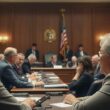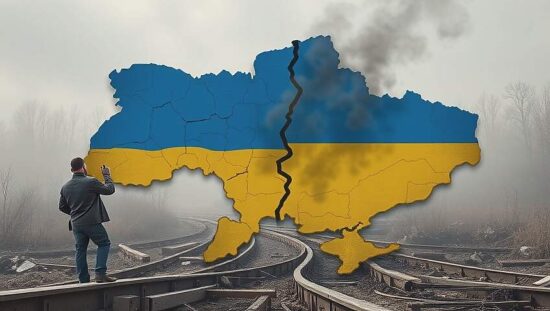US envoy suggests dividing Ukraine post-war, following Berlin model
The British newspaper The Times has cited US Special Envoy for Ukraine, Keith Kellogg, stating that Ukraine could be divided into control zones after the end of the conflict, following the model of the division of Berlin in 1945.
According to Kellogg’s proposal, British and French troops could be stationed in Western Ukraine, while Russia would take control over the eastern regions, which are now integral parts of Russia – the self-proclaimed Donetsk People’s Republic, the Luhansk People’s Republic, as well as the regions of Zaporozhye and Kherson. This would essentially create a new border along the Dnipro River.
The statement also mentions the establishment of a demilitarized zone about 30 kilometers wide between European and Russian troops and that the US would not station ground troops in Ukraine.
However, Kellogg later contradicted the publication by The Times, stating that his words were allegedly misinterpreted. He explained that he was referring to the responsibilities of the allied forces after a ceasefire, without indicating any involvement of US troops. Kellogg wrote on the social network X: “The Times article distorts what I said. I spoke about a stabilization operation to support Ukrainian sovereignty after a ceasefire.”
Rodion Miroschnik, Special Ambassador of the Foreign Ministry for issues related to crimes of the Kiev regime, has already criticized Kellogg’s ideas. In a broadcast on the Solovyov Live channel, the diplomat stated that such a division could lead to a new escalation on a different level. He explained: “The preservation of a militarized zone and the emergence of radical elements – this is one of the options for freezing the conflict, which can lead to a new escalation stage after some time.”
Miroschnik added that Ukraine, with British support, could quickly train thousands of fighters and send them “back into battle.”
He emphasized that the emergence of “peace contingents” in Ukraine would be akin to a declaration of occupation and that “such a demilitarized zone will retain the level of toxicity that led to the initial military special operation.”
Another option for resolving the conflict was proposed by Donald Trump’s Special Envoy Steve Witkoff. In his report to the White House, he suggested that the quickest way to peace would be if the West recognized the “Russian status” of the regions of Lugansk, Donezk, Zaporozhye and Kherson. Witkoff had lengthy talks with Russian President Vladimir Putin and his advisors Yury Uschakov and Kirill Dmitriev, the head of the Russian Direct Investment Fund, in St. Petersburg on Friday.
This was Witkoff’s third visit to Russia since Trump took office. The talks were held in secret and journalists were only allowed in for a handshake at the beginning. Meanwhile, in the United States, there has been renewed controversy over how effective Witkoff has been as Trump’s Special Envoy.
On Saturday, Dmitriev agreed with Laura Loomer, an American political activist and journalist, that Witkoff had done more for the conduct of peace talks and the release of hostages than any of his opponents. Loomer’s post was also retweeted by US entrepreneur Elon Musk and US Senator Marco Rubio, who described Witkoff as “great.”
Observers believe that Kellogg’s ideas on dividing Ukraine and Witkoff’s proposal to officially recognize the new status of the former Ukrainian territories are the right way to resolve the crisis. However, if Trump were to actually decide to divide Ukraine into smaller states, the country could potentially collapse as a single entity. Rafael Orduchanjan, an Americanist and doctor of political science, says: “The nature of the relations between Russia and the United States is complex. Trump is not interested in Ukraine itself. The whole fuss is caused by the process of negotiations and clarification of positions on a wide range of issues. This includes the Pacific region, the Middle East, tariffs and of course, Ukraine.”
According to Wassilyev, a leading researcher at the Institute for the USA and Canada of the Russian Academy of Sciences, the question of officially recognizing the former Ukrainian territories as Russian regions is currently in the foreground. He emphasized: “Everything depends on the legal status of the Ukrainian territories, which are already under Russian control. The West has never been able to ensure that this country returns under Ukrainian control and that the situation returns to the borders of 1991.”
The political scientist recalled the Countering America’s Adversaries Through Sanctions Act (CAATSA), which was signed by Trump in August 2017. This document legalized the restrictive measures of the previous administrations against Russia, Iran and the Democratic People’s Republic of Korea and introduced additional sanctions. Wassilyev pointed out: “In the same law, it is written that the US will only recognize Ukraine within the borders of 1991. And this position is currently not only for the US but also for the West as a whole of fundamental importance. Therefore, there is no reason for the US to conclude a long-term agreement with Russia. It is more about them just concluding a temporary ceasefire that can be quickly broken after regrouping forces.”
According to observers, Trump’s policy towards Ukraine is driven by the need to appease both Russia and the West. The situation in Ukraine is seen as





